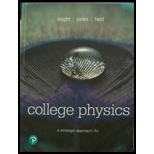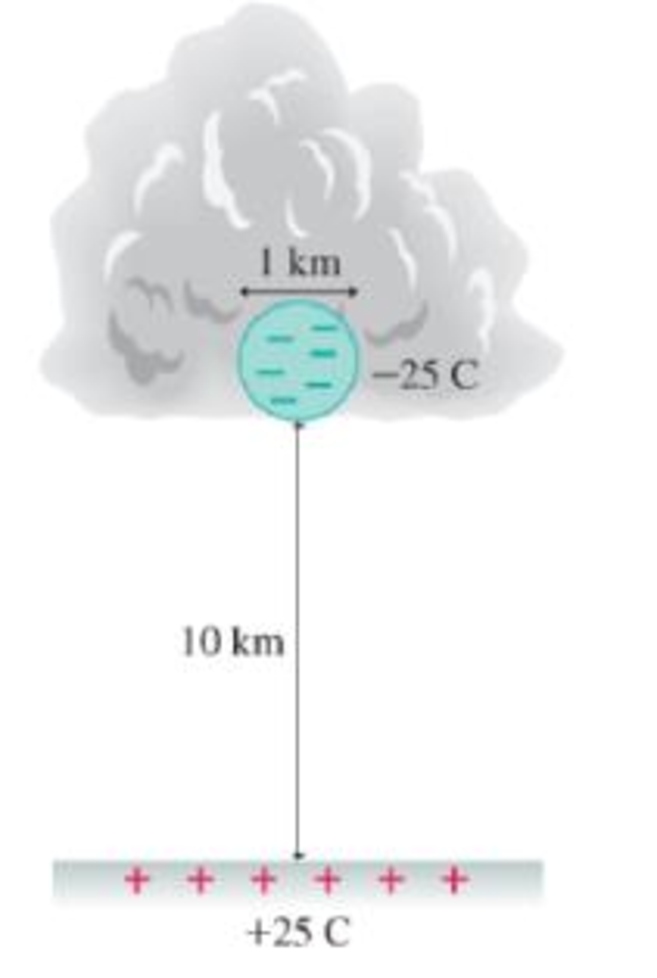
Concept explainers
A Lightning Strike
Storm clouds build up large negative charges, as described in the chapter. The charges dwell in charge centers, regions of concentrated charge. Suppose a cloud has –25 C in a 1.0|dash|km|dash|diameter spherical charge center located 10 km above the ground, as sketched in Figure P21.86. The negative charge center attracts a similar amount of positive charge that is spread on the ground below the cloud.
Figure P21.86

The charge center and the ground function as a charged capacitor, with a potential difference of approximately 4 × 108 V. The large electric field between these two "electrodes" may ionize the air, leading to a
What is the approximate capacitance of the charge center +ground system?
A. 6 × 10–8F
B. 2 × 107 F
C. 4 × 106 F
D. 8 × 106 F
Want to see the full answer?
Check out a sample textbook solution
Chapter 21 Solutions
Pearson eText for College Physics: A Strategic Approach -- Instant Access (Pearson+)
Additional Science Textbook Solutions
Applications and Investigations in Earth Science (9th Edition)
Microbiology with Diseases by Body System (5th Edition)
Anatomy & Physiology (6th Edition)
Concepts of Genetics (12th Edition)
Organic Chemistry (8th Edition)
Chemistry: Structure and Properties (2nd Edition)
- In the Donkey Kong Country video games you often get around by shooting yourself out of barrel cannons. Donkey Kong wants to launch out of one barrel and land in a different one that is a distance in x of 9.28 m away. To do so he launches himself at a velocity of 22.6 m/s at an angle of 30.0°. At what height does the 2nd barrel need to be for Donkey Kong to land in it? (measure from the height of barrel 1, aka y0=0)arrow_forwardFor which value of θ is the range of a projectile fired from ground level a maximum? 90° above the horizontal 45° above the horizontal 55° above the horizontal 30° above the horizontal 60° above the horizontalarrow_forwardA map from The Legend of Zelda: The Breath of the Wild shows that Zora's Domain is 7.55 km in a direction 25.0° north of east from Gerudo Town. The same map shows that the Korok Forest is 3.13 km in a direction 55.0° west of north from Zora's Domain. The figure below shows the location of these three places. Modeling Hyrule as flat, use this information to find the displacement from Gerudo Town to Korok Forest. What is the magnitude of the displacement? Find the angle of the displacement. Measure the angle in degrees north of east of Gerudo Town.arrow_forward
- Race car driver is cruising down the street at a constant speed of 28.9 m/s (~65 mph; he has a “lead” foot) when the traffic light in front of him turns red. a) If the driver’s reaction time is 160 ms, how far does he and his car travel down the road from the instant he sees the light change to the instant he begins to slow down? b) If the driver’s combined reaction and movement time is 750 ms, how far do he and his car travel down the road from the instant he sees the light change to the instant he slams on her brakes and car begins to slow down? c) If the driver’s average rate of acceleration is -9.5 m/s2 as he slows down, how long does it take him to come to a stop (use information about his speed of 28.9 m/s but do NOT use his reaction and movement time in this computation)? Please answer parts a-c. Show all work. For each question draw a diagram to show the vector/s. Show all the step and provide units in the answers. Provide answer to 2 decimal places unless stated otherwise.arrow_forwardBelow you will find 100 m split times for the American and France men’s 4x100 meter free style relay race during the 2008 Beijing Summer Olympics). Answer questions a-d. a) What was the total race time for each team, in seconds? b) Which team won the race? What was the difference in the teams’ times? c) What was the average speed for each team for the whole race? (provide answer to 3 decimal places). d) Calculate the average speed for each swimmer and report the results in a table like the one above. Remember to show the calculation steps. (provide answer to 3 decimal places). PLEASE SHOW ALL WORK AND STEPS.arrow_forwardNeed complete solution Pleasearrow_forward
- Below you will find 100 m split times for the American and France men’s 4x100 meter free style relay race during the 2008 Beijing Summer Olympics). Fill out the chart below. Calculate average speed per split (m/s). Show all work.arrow_forwardThe magnitude of vector →A i s 261. m and points in the direction 349.° counterclockwise from the positive x-axis. Calculate the x-component of this vector . Calculate the y-component of this vector.arrow_forwardNo chatgpt pls will upvotearrow_forward
 Physics for Scientists and Engineers: Foundations...PhysicsISBN:9781133939146Author:Katz, Debora M.Publisher:Cengage Learning
Physics for Scientists and Engineers: Foundations...PhysicsISBN:9781133939146Author:Katz, Debora M.Publisher:Cengage Learning Principles of Physics: A Calculus-Based TextPhysicsISBN:9781133104261Author:Raymond A. Serway, John W. JewettPublisher:Cengage Learning
Principles of Physics: A Calculus-Based TextPhysicsISBN:9781133104261Author:Raymond A. Serway, John W. JewettPublisher:Cengage Learning College PhysicsPhysicsISBN:9781938168000Author:Paul Peter Urone, Roger HinrichsPublisher:OpenStax College
College PhysicsPhysicsISBN:9781938168000Author:Paul Peter Urone, Roger HinrichsPublisher:OpenStax College College PhysicsPhysicsISBN:9781285737027Author:Raymond A. Serway, Chris VuillePublisher:Cengage Learning
College PhysicsPhysicsISBN:9781285737027Author:Raymond A. Serway, Chris VuillePublisher:Cengage Learning Physics for Scientists and Engineers, Technology ...PhysicsISBN:9781305116399Author:Raymond A. Serway, John W. JewettPublisher:Cengage Learning
Physics for Scientists and Engineers, Technology ...PhysicsISBN:9781305116399Author:Raymond A. Serway, John W. JewettPublisher:Cengage Learning Physics for Scientists and EngineersPhysicsISBN:9781337553278Author:Raymond A. Serway, John W. JewettPublisher:Cengage Learning
Physics for Scientists and EngineersPhysicsISBN:9781337553278Author:Raymond A. Serway, John W. JewettPublisher:Cengage Learning





